Nursing Care for Older Patients with Diabetes: A Holistic Approach
VerifiedAdded on 2019/12/04
|11
|4000
|154
Essay
AI Summary
According to Dunning (2016), diabetes is a lifelong disease that affects the physical and mental wellbeing of older patients, and it can be delayed among older individuals through early diagnosis and effective care. The article highlights the importance of providing dietary requirements for diabetic patients, particularly elderly people who have special nutritional needs. It also emphasizes the need to clarify roles and responsibilities among healthcare professionals, including diabetes specialist nurses (DSNs), practice nurses, and district nurses. Additionally, the article stresses the significance of foot care and podiatry services, as well as access to opthalmological services for residents in care homes.
Contribute Materials
Your contribution can guide someone’s learning journey. Share your
documents today.

Diabetes
Secure Best Marks with AI Grader
Need help grading? Try our AI Grader for instant feedback on your assignments.
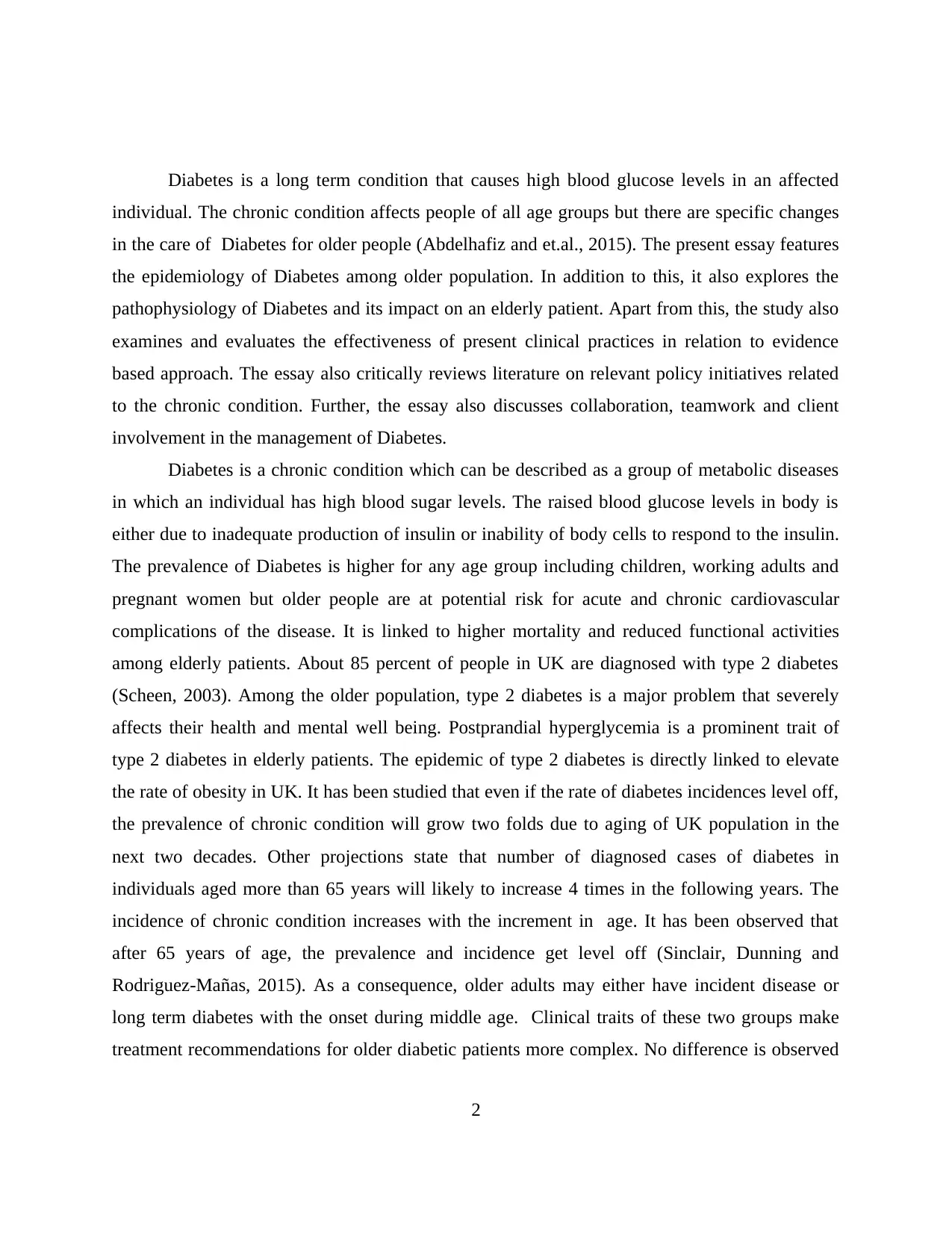
Diabetes is a long term condition that causes high blood glucose levels in an affected
individual. The chronic condition affects people of all age groups but there are specific changes
in the care of Diabetes for older people (Abdelhafiz and et.al., 2015). The present essay features
the epidemiology of Diabetes among older population. In addition to this, it also explores the
pathophysiology of Diabetes and its impact on an elderly patient. Apart from this, the study also
examines and evaluates the effectiveness of present clinical practices in relation to evidence
based approach. The essay also critically reviews literature on relevant policy initiatives related
to the chronic condition. Further, the essay also discusses collaboration, teamwork and client
involvement in the management of Diabetes.
Diabetes is a chronic condition which can be described as a group of metabolic diseases
in which an individual has high blood sugar levels. The raised blood glucose levels in body is
either due to inadequate production of insulin or inability of body cells to respond to the insulin.
The prevalence of Diabetes is higher for any age group including children, working adults and
pregnant women but older people are at potential risk for acute and chronic cardiovascular
complications of the disease. It is linked to higher mortality and reduced functional activities
among elderly patients. About 85 percent of people in UK are diagnosed with type 2 diabetes
(Scheen, 2003). Among the older population, type 2 diabetes is a major problem that severely
affects their health and mental well being. Postprandial hyperglycemia is a prominent trait of
type 2 diabetes in elderly patients. The epidemic of type 2 diabetes is directly linked to elevate
the rate of obesity in UK. It has been studied that even if the rate of diabetes incidences level off,
the prevalence of chronic condition will grow two folds due to aging of UK population in the
next two decades. Other projections state that number of diagnosed cases of diabetes in
individuals aged more than 65 years will likely to increase 4 times in the following years. The
incidence of chronic condition increases with the increment in age. It has been observed that
after 65 years of age, the prevalence and incidence get level off (Sinclair, Dunning and
Rodriguez-Mañas, 2015). As a consequence, older adults may either have incident disease or
long term diabetes with the onset during middle age. Clinical traits of these two groups make
treatment recommendations for older diabetic patients more complex. No difference is observed
2
individual. The chronic condition affects people of all age groups but there are specific changes
in the care of Diabetes for older people (Abdelhafiz and et.al., 2015). The present essay features
the epidemiology of Diabetes among older population. In addition to this, it also explores the
pathophysiology of Diabetes and its impact on an elderly patient. Apart from this, the study also
examines and evaluates the effectiveness of present clinical practices in relation to evidence
based approach. The essay also critically reviews literature on relevant policy initiatives related
to the chronic condition. Further, the essay also discusses collaboration, teamwork and client
involvement in the management of Diabetes.
Diabetes is a chronic condition which can be described as a group of metabolic diseases
in which an individual has high blood sugar levels. The raised blood glucose levels in body is
either due to inadequate production of insulin or inability of body cells to respond to the insulin.
The prevalence of Diabetes is higher for any age group including children, working adults and
pregnant women but older people are at potential risk for acute and chronic cardiovascular
complications of the disease. It is linked to higher mortality and reduced functional activities
among elderly patients. About 85 percent of people in UK are diagnosed with type 2 diabetes
(Scheen, 2003). Among the older population, type 2 diabetes is a major problem that severely
affects their health and mental well being. Postprandial hyperglycemia is a prominent trait of
type 2 diabetes in elderly patients. The epidemic of type 2 diabetes is directly linked to elevate
the rate of obesity in UK. It has been studied that even if the rate of diabetes incidences level off,
the prevalence of chronic condition will grow two folds due to aging of UK population in the
next two decades. Other projections state that number of diagnosed cases of diabetes in
individuals aged more than 65 years will likely to increase 4 times in the following years. The
incidence of chronic condition increases with the increment in age. It has been observed that
after 65 years of age, the prevalence and incidence get level off (Sinclair, Dunning and
Rodriguez-Mañas, 2015). As a consequence, older adults may either have incident disease or
long term diabetes with the onset during middle age. Clinical traits of these two groups make
treatment recommendations for older diabetic patients more complex. No difference is observed
2
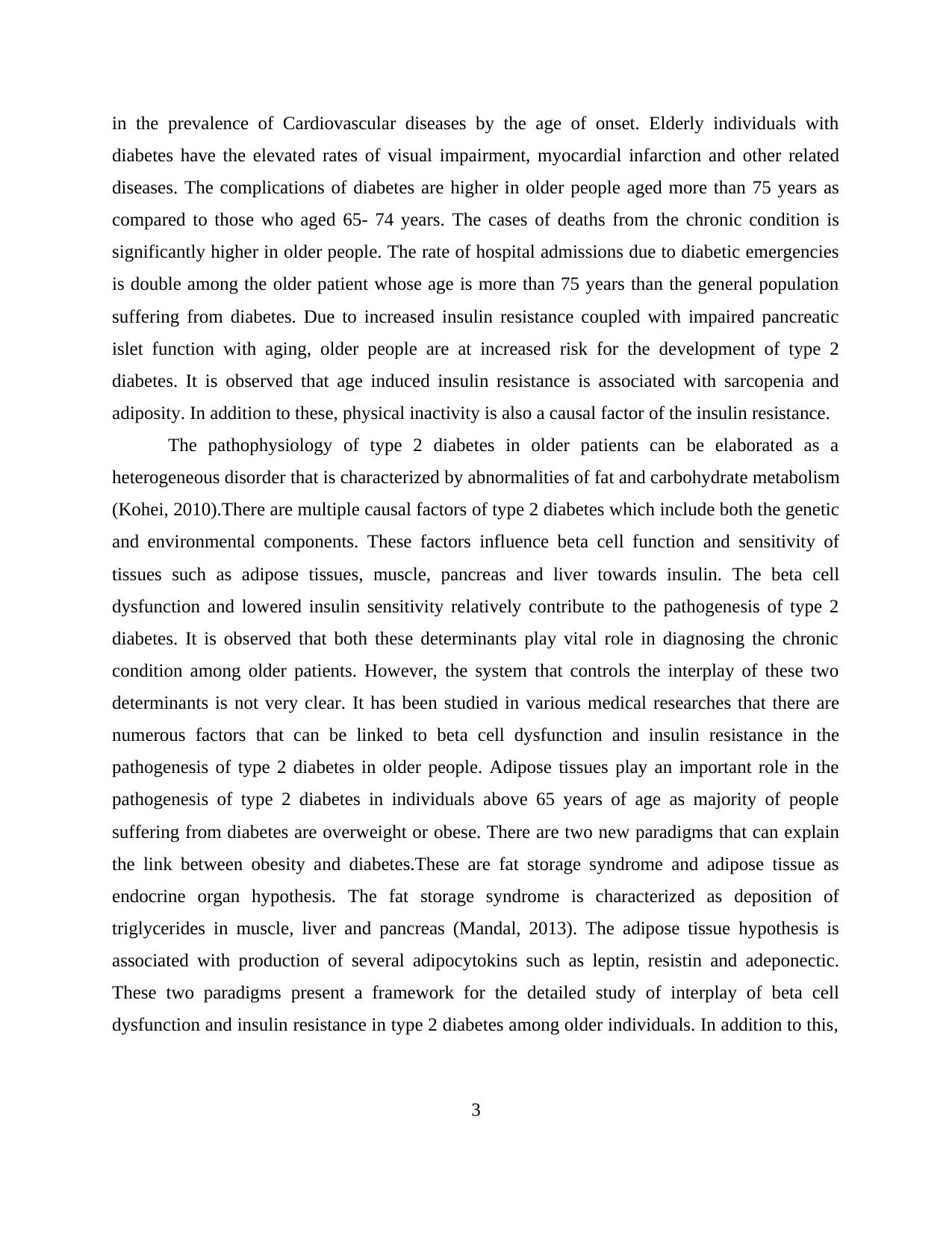
in the prevalence of Cardiovascular diseases by the age of onset. Elderly individuals with
diabetes have the elevated rates of visual impairment, myocardial infarction and other related
diseases. The complications of diabetes are higher in older people aged more than 75 years as
compared to those who aged 65- 74 years. The cases of deaths from the chronic condition is
significantly higher in older people. The rate of hospital admissions due to diabetic emergencies
is double among the older patient whose age is more than 75 years than the general population
suffering from diabetes. Due to increased insulin resistance coupled with impaired pancreatic
islet function with aging, older people are at increased risk for the development of type 2
diabetes. It is observed that age induced insulin resistance is associated with sarcopenia and
adiposity. In addition to these, physical inactivity is also a causal factor of the insulin resistance.
The pathophysiology of type 2 diabetes in older patients can be elaborated as a
heterogeneous disorder that is characterized by abnormalities of fat and carbohydrate metabolism
(Kohei, 2010).There are multiple causal factors of type 2 diabetes which include both the genetic
and environmental components. These factors influence beta cell function and sensitivity of
tissues such as adipose tissues, muscle, pancreas and liver towards insulin. The beta cell
dysfunction and lowered insulin sensitivity relatively contribute to the pathogenesis of type 2
diabetes. It is observed that both these determinants play vital role in diagnosing the chronic
condition among older patients. However, the system that controls the interplay of these two
determinants is not very clear. It has been studied in various medical researches that there are
numerous factors that can be linked to beta cell dysfunction and insulin resistance in the
pathogenesis of type 2 diabetes in older people. Adipose tissues play an important role in the
pathogenesis of type 2 diabetes in individuals above 65 years of age as majority of people
suffering from diabetes are overweight or obese. There are two new paradigms that can explain
the link between obesity and diabetes.These are fat storage syndrome and adipose tissue as
endocrine organ hypothesis. The fat storage syndrome is characterized as deposition of
triglycerides in muscle, liver and pancreas (Mandal, 2013). The adipose tissue hypothesis is
associated with production of several adipocytokins such as leptin, resistin and adeponectic.
These two paradigms present a framework for the detailed study of interplay of beta cell
dysfunction and insulin resistance in type 2 diabetes among older individuals. In addition to this,
3
diabetes have the elevated rates of visual impairment, myocardial infarction and other related
diseases. The complications of diabetes are higher in older people aged more than 75 years as
compared to those who aged 65- 74 years. The cases of deaths from the chronic condition is
significantly higher in older people. The rate of hospital admissions due to diabetic emergencies
is double among the older patient whose age is more than 75 years than the general population
suffering from diabetes. Due to increased insulin resistance coupled with impaired pancreatic
islet function with aging, older people are at increased risk for the development of type 2
diabetes. It is observed that age induced insulin resistance is associated with sarcopenia and
adiposity. In addition to these, physical inactivity is also a causal factor of the insulin resistance.
The pathophysiology of type 2 diabetes in older patients can be elaborated as a
heterogeneous disorder that is characterized by abnormalities of fat and carbohydrate metabolism
(Kohei, 2010).There are multiple causal factors of type 2 diabetes which include both the genetic
and environmental components. These factors influence beta cell function and sensitivity of
tissues such as adipose tissues, muscle, pancreas and liver towards insulin. The beta cell
dysfunction and lowered insulin sensitivity relatively contribute to the pathogenesis of type 2
diabetes. It is observed that both these determinants play vital role in diagnosing the chronic
condition among older patients. However, the system that controls the interplay of these two
determinants is not very clear. It has been studied in various medical researches that there are
numerous factors that can be linked to beta cell dysfunction and insulin resistance in the
pathogenesis of type 2 diabetes in older people. Adipose tissues play an important role in the
pathogenesis of type 2 diabetes in individuals above 65 years of age as majority of people
suffering from diabetes are overweight or obese. There are two new paradigms that can explain
the link between obesity and diabetes.These are fat storage syndrome and adipose tissue as
endocrine organ hypothesis. The fat storage syndrome is characterized as deposition of
triglycerides in muscle, liver and pancreas (Mandal, 2013). The adipose tissue hypothesis is
associated with production of several adipocytokins such as leptin, resistin and adeponectic.
These two paradigms present a framework for the detailed study of interplay of beta cell
dysfunction and insulin resistance in type 2 diabetes among older individuals. In addition to this,
3

these paradigms play cardinal role in studying the genetic and environmental factors that are
responsible for diabetes and its risk in the coming decades.
Diabetes is a lifelong condition that significantly impacts the health and well being of
older patients. Older patients are diagnosed with type 2 diabetes experience symptoms that
include lack of sleep, inability to concentrate, confusion, poor appetite, cognitive dysfunction,
confusion, violent behavior, difficulty in speech and self-care, heart attacks and stroke etc. It is
often observed that lack of early diagnosis of the long term condition severely impacts the
mental health of older patients. Depression is very common among older diabetic patients due to
painful neuropathy and negative effects of medication. In addition to this, foot ulceration also
contributes to the development of depression among elderly population. Prolonged
hospitalization also increases the risk of delirium and dementia which further complicate the
management of type 2 diabetes in older individuals (Yaffe and et.al., 2013). Cognitive
dysfunction increase the risk of Alzheimer's and other mental disorders in elderly patients
suffering from type 2 diabetes. Another risk factors for functional impairment is contributed to
both aging and diabetes. It has been found that peripheral neuropathy present in majority of
elderly diabetic patients elevates the risk of balance problems and instability related to posture,
minimal physical activity and higher risks of falls. Besides this, other medical conditions that
follows diabetes in older patients and negatively affect functionality and physical activity are
obesity, stroke, visual impairment, cardiovascular diseases and degenerative joint ailments.
Poly pharmacy severely hit older diabetic patients in which they are adversely affected
by the side effects of drugs. Poly pharmacy can be referred to use of six or more prescription
medication for treating diabetes in older care takers (Kirkman and et.al., 2012). It is the biggest
challenge in the treatment of type 2 diabetes in older patients. Care professionals deliberately use
drugs to control and reduce the risk of complications of the lifelong chronic disease. Other than
this, falls and fractures are commonly found to impact diabetic patients. The risk of falls and
fractures are higher in older female patients. It has been observed that prevention of severity of
type 2 diabetes can significantly reduce the risk of falls and fractures among older people.
Besides this, vision and hearing impairment are also prevalent in older people with diabetes
which is significantly linked to neuropathy and vascular diseases. Apart from these, painful
neuropathy and inadequate treatment may lead to severe outcomes in elderly care takers which
4
responsible for diabetes and its risk in the coming decades.
Diabetes is a lifelong condition that significantly impacts the health and well being of
older patients. Older patients are diagnosed with type 2 diabetes experience symptoms that
include lack of sleep, inability to concentrate, confusion, poor appetite, cognitive dysfunction,
confusion, violent behavior, difficulty in speech and self-care, heart attacks and stroke etc. It is
often observed that lack of early diagnosis of the long term condition severely impacts the
mental health of older patients. Depression is very common among older diabetic patients due to
painful neuropathy and negative effects of medication. In addition to this, foot ulceration also
contributes to the development of depression among elderly population. Prolonged
hospitalization also increases the risk of delirium and dementia which further complicate the
management of type 2 diabetes in older individuals (Yaffe and et.al., 2013). Cognitive
dysfunction increase the risk of Alzheimer's and other mental disorders in elderly patients
suffering from type 2 diabetes. Another risk factors for functional impairment is contributed to
both aging and diabetes. It has been found that peripheral neuropathy present in majority of
elderly diabetic patients elevates the risk of balance problems and instability related to posture,
minimal physical activity and higher risks of falls. Besides this, other medical conditions that
follows diabetes in older patients and negatively affect functionality and physical activity are
obesity, stroke, visual impairment, cardiovascular diseases and degenerative joint ailments.
Poly pharmacy severely hit older diabetic patients in which they are adversely affected
by the side effects of drugs. Poly pharmacy can be referred to use of six or more prescription
medication for treating diabetes in older care takers (Kirkman and et.al., 2012). It is the biggest
challenge in the treatment of type 2 diabetes in older patients. Care professionals deliberately use
drugs to control and reduce the risk of complications of the lifelong chronic disease. Other than
this, falls and fractures are commonly found to impact diabetic patients. The risk of falls and
fractures are higher in older female patients. It has been observed that prevention of severity of
type 2 diabetes can significantly reduce the risk of falls and fractures among older people.
Besides this, vision and hearing impairment are also prevalent in older people with diabetes
which is significantly linked to neuropathy and vascular diseases. Apart from these, painful
neuropathy and inadequate treatment may lead to severe outcomes in elderly care takers which
4
Secure Best Marks with AI Grader
Need help grading? Try our AI Grader for instant feedback on your assignments.
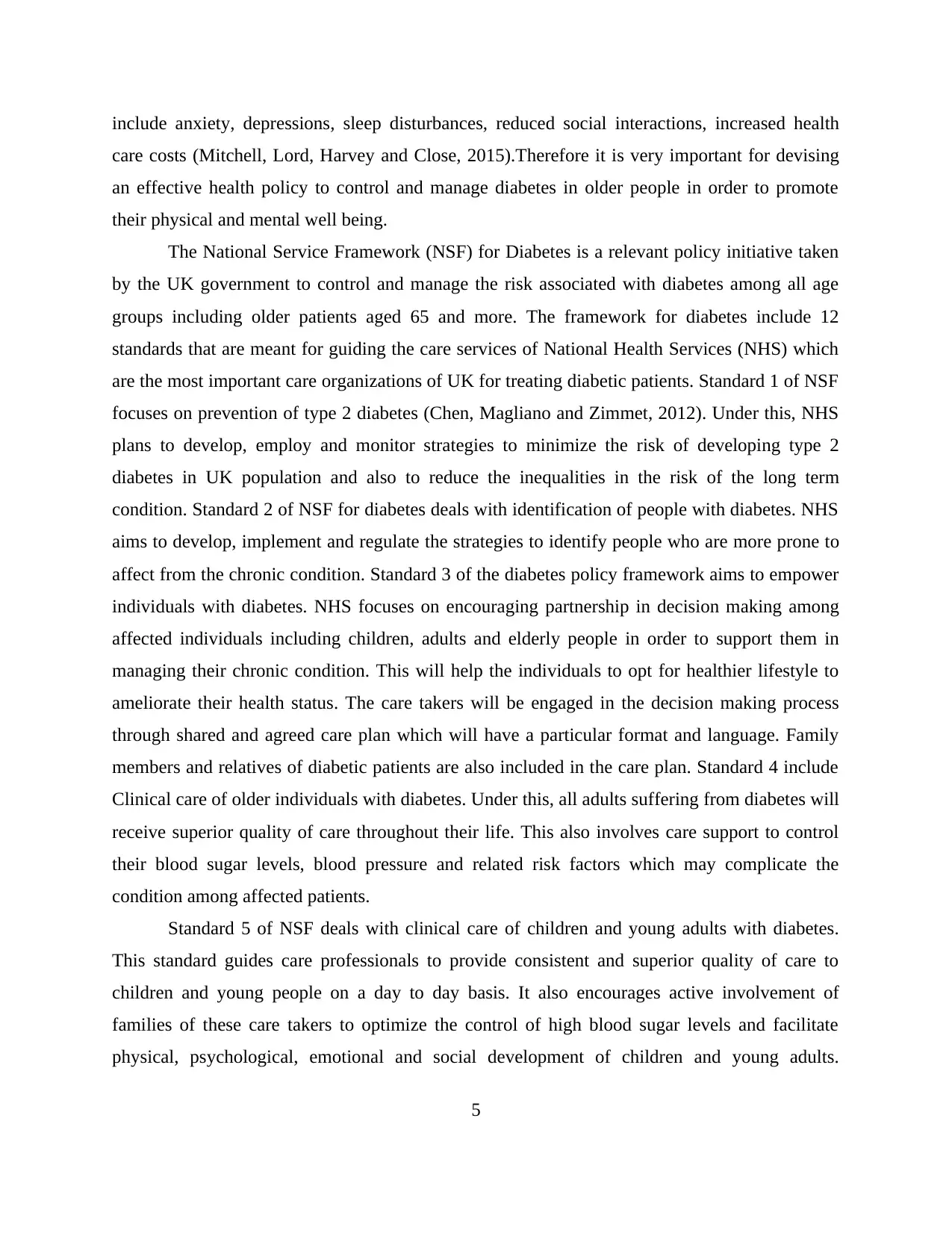
include anxiety, depressions, sleep disturbances, reduced social interactions, increased health
care costs (Mitchell, Lord, Harvey and Close, 2015).Therefore it is very important for devising
an effective health policy to control and manage diabetes in older people in order to promote
their physical and mental well being.
The National Service Framework (NSF) for Diabetes is a relevant policy initiative taken
by the UK government to control and manage the risk associated with diabetes among all age
groups including older patients aged 65 and more. The framework for diabetes include 12
standards that are meant for guiding the care services of National Health Services (NHS) which
are the most important care organizations of UK for treating diabetic patients. Standard 1 of NSF
focuses on prevention of type 2 diabetes (Chen, Magliano and Zimmet, 2012). Under this, NHS
plans to develop, employ and monitor strategies to minimize the risk of developing type 2
diabetes in UK population and also to reduce the inequalities in the risk of the long term
condition. Standard 2 of NSF for diabetes deals with identification of people with diabetes. NHS
aims to develop, implement and regulate the strategies to identify people who are more prone to
affect from the chronic condition. Standard 3 of the diabetes policy framework aims to empower
individuals with diabetes. NHS focuses on encouraging partnership in decision making among
affected individuals including children, adults and elderly people in order to support them in
managing their chronic condition. This will help the individuals to opt for healthier lifestyle to
ameliorate their health status. The care takers will be engaged in the decision making process
through shared and agreed care plan which will have a particular format and language. Family
members and relatives of diabetic patients are also included in the care plan. Standard 4 include
Clinical care of older individuals with diabetes. Under this, all adults suffering from diabetes will
receive superior quality of care throughout their life. This also involves care support to control
their blood sugar levels, blood pressure and related risk factors which may complicate the
condition among affected patients.
Standard 5 of NSF deals with clinical care of children and young adults with diabetes.
This standard guides care professionals to provide consistent and superior quality of care to
children and young people on a day to day basis. It also encourages active involvement of
families of these care takers to optimize the control of high blood sugar levels and facilitate
physical, psychological, emotional and social development of children and young adults.
5
care costs (Mitchell, Lord, Harvey and Close, 2015).Therefore it is very important for devising
an effective health policy to control and manage diabetes in older people in order to promote
their physical and mental well being.
The National Service Framework (NSF) for Diabetes is a relevant policy initiative taken
by the UK government to control and manage the risk associated with diabetes among all age
groups including older patients aged 65 and more. The framework for diabetes include 12
standards that are meant for guiding the care services of National Health Services (NHS) which
are the most important care organizations of UK for treating diabetic patients. Standard 1 of NSF
focuses on prevention of type 2 diabetes (Chen, Magliano and Zimmet, 2012). Under this, NHS
plans to develop, employ and monitor strategies to minimize the risk of developing type 2
diabetes in UK population and also to reduce the inequalities in the risk of the long term
condition. Standard 2 of NSF for diabetes deals with identification of people with diabetes. NHS
aims to develop, implement and regulate the strategies to identify people who are more prone to
affect from the chronic condition. Standard 3 of the diabetes policy framework aims to empower
individuals with diabetes. NHS focuses on encouraging partnership in decision making among
affected individuals including children, adults and elderly people in order to support them in
managing their chronic condition. This will help the individuals to opt for healthier lifestyle to
ameliorate their health status. The care takers will be engaged in the decision making process
through shared and agreed care plan which will have a particular format and language. Family
members and relatives of diabetic patients are also included in the care plan. Standard 4 include
Clinical care of older individuals with diabetes. Under this, all adults suffering from diabetes will
receive superior quality of care throughout their life. This also involves care support to control
their blood sugar levels, blood pressure and related risk factors which may complicate the
condition among affected patients.
Standard 5 of NSF deals with clinical care of children and young adults with diabetes.
This standard guides care professionals to provide consistent and superior quality of care to
children and young people on a day to day basis. It also encourages active involvement of
families of these care takers to optimize the control of high blood sugar levels and facilitate
physical, psychological, emotional and social development of children and young adults.
5
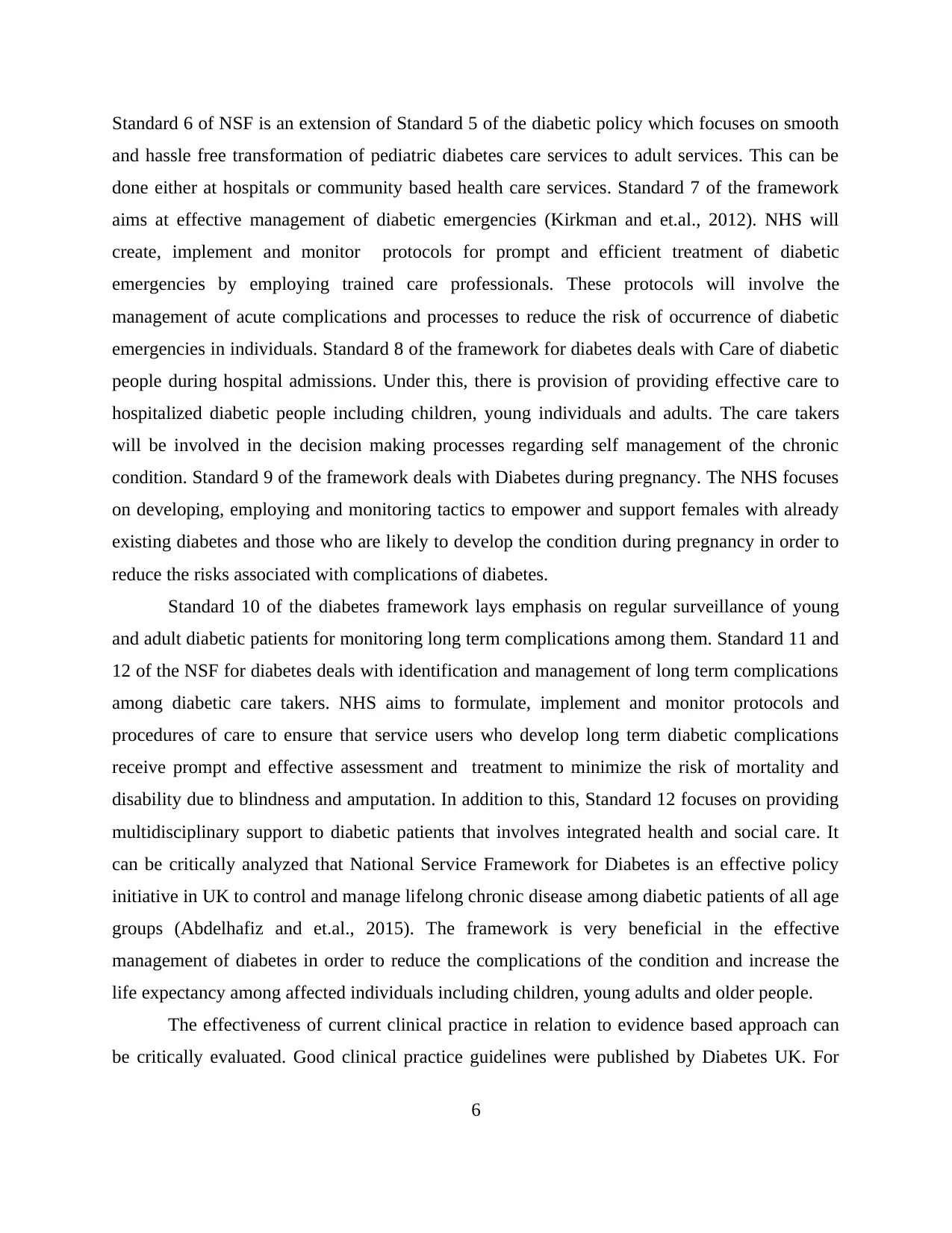
Standard 6 of NSF is an extension of Standard 5 of the diabetic policy which focuses on smooth
and hassle free transformation of pediatric diabetes care services to adult services. This can be
done either at hospitals or community based health care services. Standard 7 of the framework
aims at effective management of diabetic emergencies (Kirkman and et.al., 2012). NHS will
create, implement and monitor protocols for prompt and efficient treatment of diabetic
emergencies by employing trained care professionals. These protocols will involve the
management of acute complications and processes to reduce the risk of occurrence of diabetic
emergencies in individuals. Standard 8 of the framework for diabetes deals with Care of diabetic
people during hospital admissions. Under this, there is provision of providing effective care to
hospitalized diabetic people including children, young individuals and adults. The care takers
will be involved in the decision making processes regarding self management of the chronic
condition. Standard 9 of the framework deals with Diabetes during pregnancy. The NHS focuses
on developing, employing and monitoring tactics to empower and support females with already
existing diabetes and those who are likely to develop the condition during pregnancy in order to
reduce the risks associated with complications of diabetes.
Standard 10 of the diabetes framework lays emphasis on regular surveillance of young
and adult diabetic patients for monitoring long term complications among them. Standard 11 and
12 of the NSF for diabetes deals with identification and management of long term complications
among diabetic care takers. NHS aims to formulate, implement and monitor protocols and
procedures of care to ensure that service users who develop long term diabetic complications
receive prompt and effective assessment and treatment to minimize the risk of mortality and
disability due to blindness and amputation. In addition to this, Standard 12 focuses on providing
multidisciplinary support to diabetic patients that involves integrated health and social care. It
can be critically analyzed that National Service Framework for Diabetes is an effective policy
initiative in UK to control and manage lifelong chronic disease among diabetic patients of all age
groups (Abdelhafiz and et.al., 2015). The framework is very beneficial in the effective
management of diabetes in order to reduce the complications of the condition and increase the
life expectancy among affected individuals including children, young adults and older people.
The effectiveness of current clinical practice in relation to evidence based approach can
be critically evaluated. Good clinical practice guidelines were published by Diabetes UK. For
6
and hassle free transformation of pediatric diabetes care services to adult services. This can be
done either at hospitals or community based health care services. Standard 7 of the framework
aims at effective management of diabetic emergencies (Kirkman and et.al., 2012). NHS will
create, implement and monitor protocols for prompt and efficient treatment of diabetic
emergencies by employing trained care professionals. These protocols will involve the
management of acute complications and processes to reduce the risk of occurrence of diabetic
emergencies in individuals. Standard 8 of the framework for diabetes deals with Care of diabetic
people during hospital admissions. Under this, there is provision of providing effective care to
hospitalized diabetic people including children, young individuals and adults. The care takers
will be involved in the decision making processes regarding self management of the chronic
condition. Standard 9 of the framework deals with Diabetes during pregnancy. The NHS focuses
on developing, employing and monitoring tactics to empower and support females with already
existing diabetes and those who are likely to develop the condition during pregnancy in order to
reduce the risks associated with complications of diabetes.
Standard 10 of the diabetes framework lays emphasis on regular surveillance of young
and adult diabetic patients for monitoring long term complications among them. Standard 11 and
12 of the NSF for diabetes deals with identification and management of long term complications
among diabetic care takers. NHS aims to formulate, implement and monitor protocols and
procedures of care to ensure that service users who develop long term diabetic complications
receive prompt and effective assessment and treatment to minimize the risk of mortality and
disability due to blindness and amputation. In addition to this, Standard 12 focuses on providing
multidisciplinary support to diabetic patients that involves integrated health and social care. It
can be critically analyzed that National Service Framework for Diabetes is an effective policy
initiative in UK to control and manage lifelong chronic disease among diabetic patients of all age
groups (Abdelhafiz and et.al., 2015). The framework is very beneficial in the effective
management of diabetes in order to reduce the complications of the condition and increase the
life expectancy among affected individuals including children, young adults and older people.
The effectiveness of current clinical practice in relation to evidence based approach can
be critically evaluated. Good clinical practice guidelines were published by Diabetes UK. For
6

older people in UK, diabetes management is divided into nursing care and social care. In nursing
care, registered nursing staff provide foot care, regular monitoring of blood glucose, guidance on
self management of diabetes etc. The clinical practice in relation to management and treatment
of older people with diabetes in UK is effective (Prince and et.al., 2015). However, it can be
critically evaluated that follow up practices are poor. Foot care is a important part of diabetes
management. However, there are other complications that dioabeti9c patients suffer from. These
include complications of kidneys, eyes etc. A gap exists as the clinical practice does not take into
account these aspects efficiently. There are people who cannot self administer insulin. This is an
important aspect which needs to be addressed. Sufficient services should be provided to these
patients. However, there is a gap in the clinical practice as the different areas of service are not
clear. There is confusion regarding who can give insulin in the nursing home, who can provide
training for insulin administration, who will provide services regarding diabetes complications
etc.
Collaborative working play very crucial role in health and social care sector in
controlling and managing the long term chronic condition. The role of health and social care
workers is very cardinal when it comes to effective treatment of diabetes in older patients. With
the advancing age, the risk of complications of other medical conditions also increases in
diabetic patients (Sherifali and Meneilly, 2015). Therefore it becomes very crucial for health
professionals in early diagnosis of diabetes in elderly patients and effective care plan need to be
developed to treat the condition. The care plan should be designed on the basis of person centric
approach. The care needs of older patients should be assessed effectively by involving them in
the decision making processes. Effective communication between care takers and health
workers create a strong bond them which is very important for developing a personalized care
plan to manage diabetes among patients. This shared decision making is considered as an
effective approach to ameliorate the quality of care services . The key aspects of shared decision
making include setting collaboration working between older patients and care providers, vital
information exchange, intention on choices and taking appropriate actions related to decisions. It
has been observed that the health care objectives of older diabetic patients is focused mostly on
their functional independence (Akrivos and et.al., 2015).The important element of improving the
communication with patients is to find the harmony between care takers objectives and medical
7
care, registered nursing staff provide foot care, regular monitoring of blood glucose, guidance on
self management of diabetes etc. The clinical practice in relation to management and treatment
of older people with diabetes in UK is effective (Prince and et.al., 2015). However, it can be
critically evaluated that follow up practices are poor. Foot care is a important part of diabetes
management. However, there are other complications that dioabeti9c patients suffer from. These
include complications of kidneys, eyes etc. A gap exists as the clinical practice does not take into
account these aspects efficiently. There are people who cannot self administer insulin. This is an
important aspect which needs to be addressed. Sufficient services should be provided to these
patients. However, there is a gap in the clinical practice as the different areas of service are not
clear. There is confusion regarding who can give insulin in the nursing home, who can provide
training for insulin administration, who will provide services regarding diabetes complications
etc.
Collaborative working play very crucial role in health and social care sector in
controlling and managing the long term chronic condition. The role of health and social care
workers is very cardinal when it comes to effective treatment of diabetes in older patients. With
the advancing age, the risk of complications of other medical conditions also increases in
diabetic patients (Sherifali and Meneilly, 2015). Therefore it becomes very crucial for health
professionals in early diagnosis of diabetes in elderly patients and effective care plan need to be
developed to treat the condition. The care plan should be designed on the basis of person centric
approach. The care needs of older patients should be assessed effectively by involving them in
the decision making processes. Effective communication between care takers and health
workers create a strong bond them which is very important for developing a personalized care
plan to manage diabetes among patients. This shared decision making is considered as an
effective approach to ameliorate the quality of care services . The key aspects of shared decision
making include setting collaboration working between older patients and care providers, vital
information exchange, intention on choices and taking appropriate actions related to decisions. It
has been observed that the health care objectives of older diabetic patients is focused mostly on
their functional independence (Akrivos and et.al., 2015).The important element of improving the
communication with patients is to find the harmony between care takers objectives and medical
7
Paraphrase This Document
Need a fresh take? Get an instant paraphrase of this document with our AI Paraphraser

goals. Clinicians mainly focus on the congruence of both the objectives while treating and
managing diabetes among older patients. The treatment becomes very difficult when patients do
not cooperate with care givers as they do not comprehend the relevance of risk associated with
complications of diabetes and value of minimizing the risk.
Therefore it is very crucial for care givers to educate patients regarding risk factors
related to complications of diabetes and encourage them to cooperate as team member to control
and manage their chronic condition (Bruce and et.al., 2015). Older people rely greatly on their
family and friends to assist them with their decisions related to treatment decisions. This is due
to their old age and dependence on others they lack the ability to take care of themselves in an
effective manner. The care professionals need to consider the nutritional requirements of older
people suffering from diabetes. Though energy needs of older people decline with age , their
macro nutrients needs remain same throughout adulthood. Thus care professionals need to
carefully conduct the assessment of nutritional needs of older people to meet their energy needs.
In addition to this, self management of diabetes in older patients also include physical activity.
Physical fitness is very important to treat the chronic condition among older care takers. With
progressive age, muscle mass and strength tends to decline which is further exacerbated by the
complications involved in the condition and admissions to hospitals (Huang and Davis, 2015). It
has been observed that regular physical activity tend to ameliorate the functional status in older
people. Thus collaborative working is very important for encouraging older people to self
manage their condition through effective care plan which include proper medication, diet and
exercise regime to reduce the complications of diabetes.
Evaluation of policy initiatives may inform future practice in various ways. These will
also help in bridging the practice gap. There should be provided adequate services for managing
diabetes associated complications such as diabetic neuropathy, diabetic nephropathy, retinopathy
etc. each of these should be paid attention (Dunning, 2016). Moreover, there is a need to provide
information to the patients regarding dietary requirements pertaining to diabetes. This is even
more important as elderly people have special requirements for proper nutrition. Roles and
responsibilities of Diabetes specialist nurse (DSN), practice nurse, district nurse should be made
clear. Foot care and podiatry services should also be provided to the older people with diabetes.
Provision of access to opthalmological services for residents of care homes will help in bridging
8
managing diabetes among older patients. The treatment becomes very difficult when patients do
not cooperate with care givers as they do not comprehend the relevance of risk associated with
complications of diabetes and value of minimizing the risk.
Therefore it is very crucial for care givers to educate patients regarding risk factors
related to complications of diabetes and encourage them to cooperate as team member to control
and manage their chronic condition (Bruce and et.al., 2015). Older people rely greatly on their
family and friends to assist them with their decisions related to treatment decisions. This is due
to their old age and dependence on others they lack the ability to take care of themselves in an
effective manner. The care professionals need to consider the nutritional requirements of older
people suffering from diabetes. Though energy needs of older people decline with age , their
macro nutrients needs remain same throughout adulthood. Thus care professionals need to
carefully conduct the assessment of nutritional needs of older people to meet their energy needs.
In addition to this, self management of diabetes in older patients also include physical activity.
Physical fitness is very important to treat the chronic condition among older care takers. With
progressive age, muscle mass and strength tends to decline which is further exacerbated by the
complications involved in the condition and admissions to hospitals (Huang and Davis, 2015). It
has been observed that regular physical activity tend to ameliorate the functional status in older
people. Thus collaborative working is very important for encouraging older people to self
manage their condition through effective care plan which include proper medication, diet and
exercise regime to reduce the complications of diabetes.
Evaluation of policy initiatives may inform future practice in various ways. These will
also help in bridging the practice gap. There should be provided adequate services for managing
diabetes associated complications such as diabetic neuropathy, diabetic nephropathy, retinopathy
etc. each of these should be paid attention (Dunning, 2016). Moreover, there is a need to provide
information to the patients regarding dietary requirements pertaining to diabetes. This is even
more important as elderly people have special requirements for proper nutrition. Roles and
responsibilities of Diabetes specialist nurse (DSN), practice nurse, district nurse should be made
clear. Foot care and podiatry services should also be provided to the older people with diabetes.
Provision of access to opthalmological services for residents of care homes will help in bridging
8
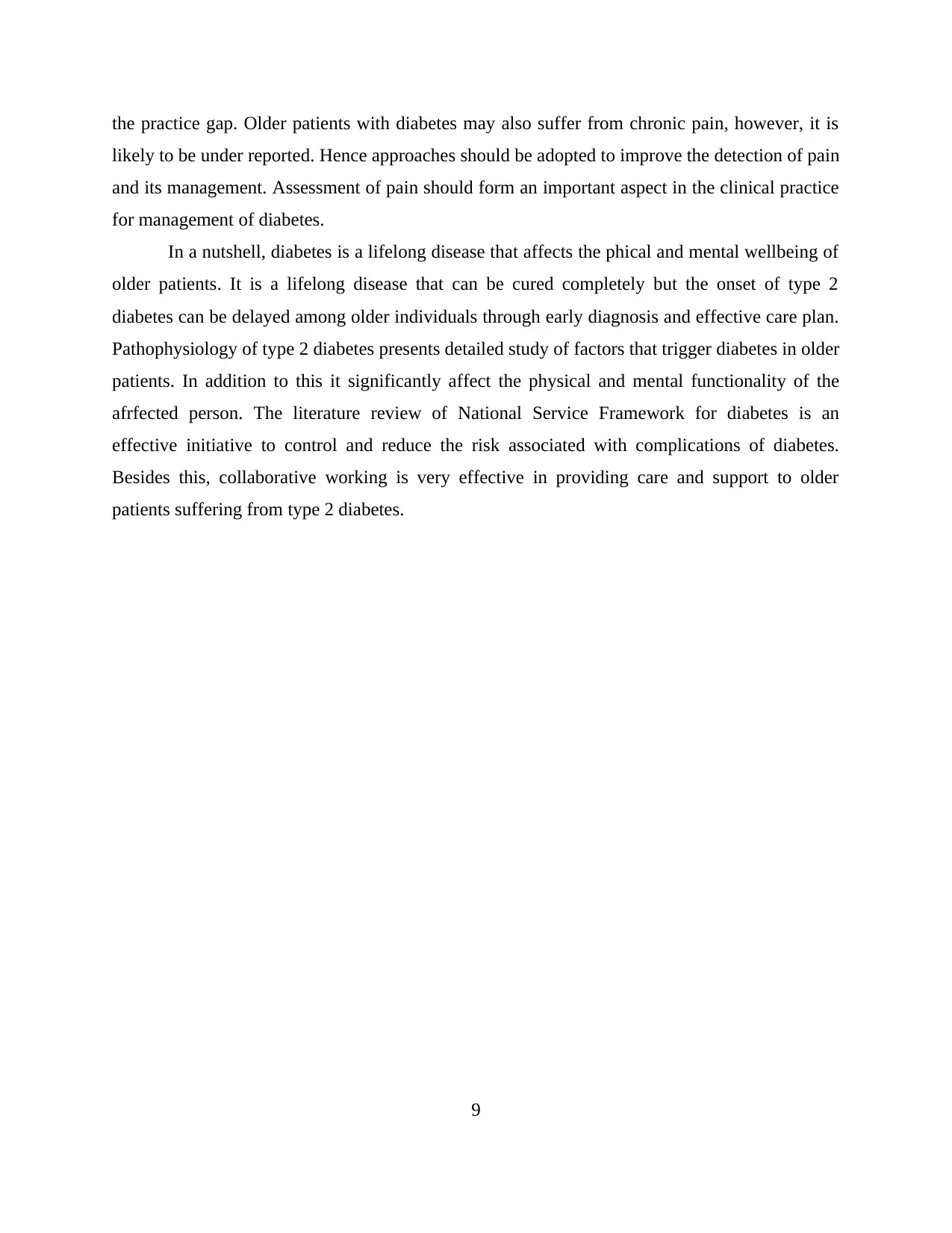
the practice gap. Older patients with diabetes may also suffer from chronic pain, however, it is
likely to be under reported. Hence approaches should be adopted to improve the detection of pain
and its management. Assessment of pain should form an important aspect in the clinical practice
for management of diabetes.
In a nutshell, diabetes is a lifelong disease that affects the phical and mental wellbeing of
older patients. It is a lifelong disease that can be cured completely but the onset of type 2
diabetes can be delayed among older individuals through early diagnosis and effective care plan.
Pathophysiology of type 2 diabetes presents detailed study of factors that trigger diabetes in older
patients. In addition to this it significantly affect the physical and mental functionality of the
afrfected person. The literature review of National Service Framework for diabetes is an
effective initiative to control and reduce the risk associated with complications of diabetes.
Besides this, collaborative working is very effective in providing care and support to older
patients suffering from type 2 diabetes.
9
likely to be under reported. Hence approaches should be adopted to improve the detection of pain
and its management. Assessment of pain should form an important aspect in the clinical practice
for management of diabetes.
In a nutshell, diabetes is a lifelong disease that affects the phical and mental wellbeing of
older patients. It is a lifelong disease that can be cured completely but the onset of type 2
diabetes can be delayed among older individuals through early diagnosis and effective care plan.
Pathophysiology of type 2 diabetes presents detailed study of factors that trigger diabetes in older
patients. In addition to this it significantly affect the physical and mental functionality of the
afrfected person. The literature review of National Service Framework for diabetes is an
effective initiative to control and reduce the risk associated with complications of diabetes.
Besides this, collaborative working is very effective in providing care and support to older
patients suffering from type 2 diabetes.
9
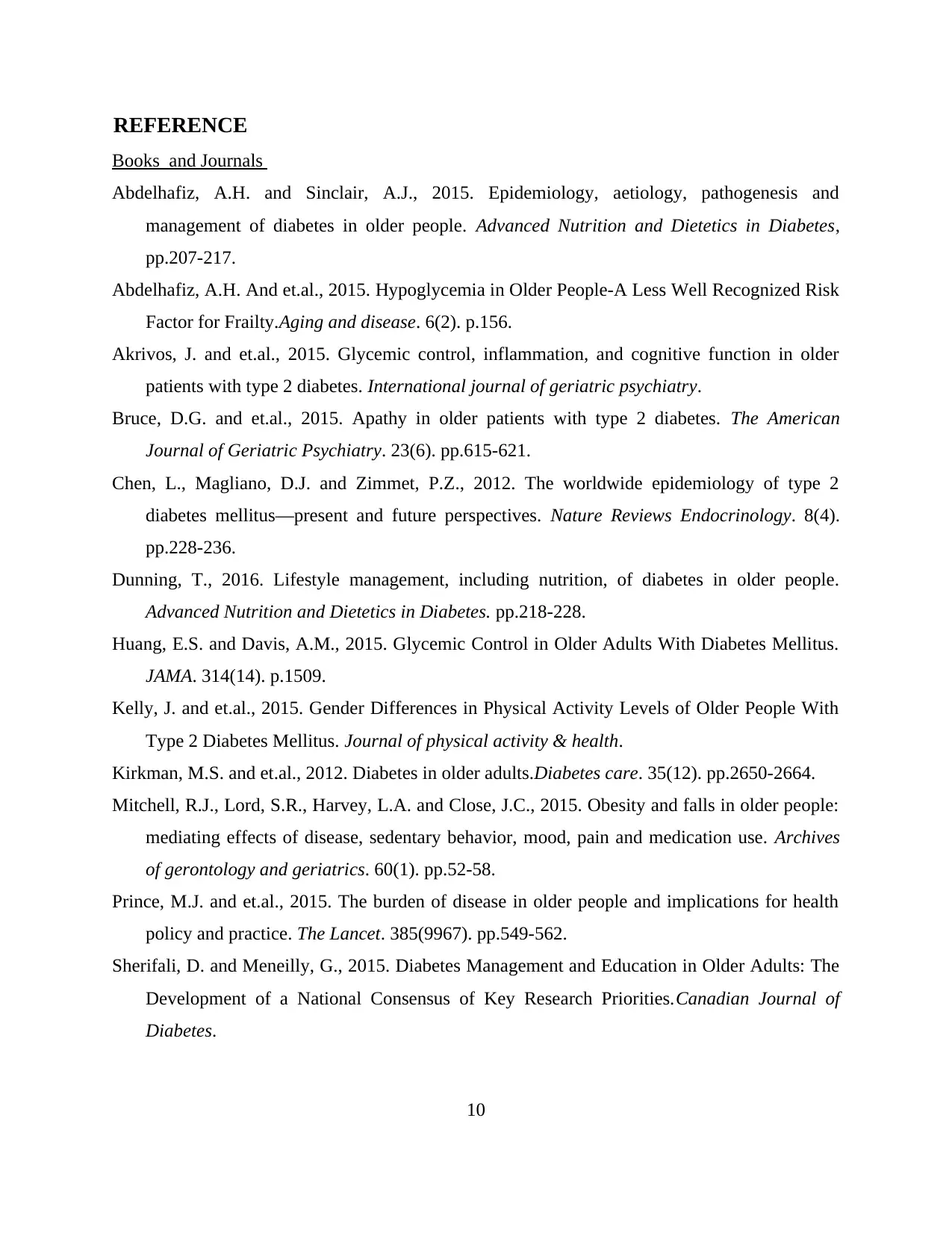
REFERENCE
Books and Journals
Abdelhafiz, A.H. and Sinclair, A.J., 2015. Epidemiology, aetiology, pathogenesis and
management of diabetes in older people. Advanced Nutrition and Dietetics in Diabetes,
pp.207-217.
Abdelhafiz, A.H. And et.al., 2015. Hypoglycemia in Older People-A Less Well Recognized Risk
Factor for Frailty.Aging and disease. 6(2). p.156.
Akrivos, J. and et.al., 2015. Glycemic control, inflammation, and cognitive function in older
patients with type 2 diabetes. International journal of geriatric psychiatry.
Bruce, D.G. and et.al., 2015. Apathy in older patients with type 2 diabetes. The American
Journal of Geriatric Psychiatry. 23(6). pp.615-621.
Chen, L., Magliano, D.J. and Zimmet, P.Z., 2012. The worldwide epidemiology of type 2
diabetes mellitus—present and future perspectives. Nature Reviews Endocrinology. 8(4).
pp.228-236.
Dunning, T., 2016. Lifestyle management, including nutrition, of diabetes in older people.
Advanced Nutrition and Dietetics in Diabetes. pp.218-228.
Huang, E.S. and Davis, A.M., 2015. Glycemic Control in Older Adults With Diabetes Mellitus.
JAMA. 314(14). p.1509.
Kelly, J. and et.al., 2015. Gender Differences in Physical Activity Levels of Older People With
Type 2 Diabetes Mellitus. Journal of physical activity & health.
Kirkman, M.S. and et.al., 2012. Diabetes in older adults.Diabetes care. 35(12). pp.2650-2664.
Mitchell, R.J., Lord, S.R., Harvey, L.A. and Close, J.C., 2015. Obesity and falls in older people:
mediating effects of disease, sedentary behavior, mood, pain and medication use. Archives
of gerontology and geriatrics. 60(1). pp.52-58.
Prince, M.J. and et.al., 2015. The burden of disease in older people and implications for health
policy and practice. The Lancet. 385(9967). pp.549-562.
Sherifali, D. and Meneilly, G., 2015. Diabetes Management and Education in Older Adults: The
Development of a National Consensus of Key Research Priorities.Canadian Journal of
Diabetes.
10
Books and Journals
Abdelhafiz, A.H. and Sinclair, A.J., 2015. Epidemiology, aetiology, pathogenesis and
management of diabetes in older people. Advanced Nutrition and Dietetics in Diabetes,
pp.207-217.
Abdelhafiz, A.H. And et.al., 2015. Hypoglycemia in Older People-A Less Well Recognized Risk
Factor for Frailty.Aging and disease. 6(2). p.156.
Akrivos, J. and et.al., 2015. Glycemic control, inflammation, and cognitive function in older
patients with type 2 diabetes. International journal of geriatric psychiatry.
Bruce, D.G. and et.al., 2015. Apathy in older patients with type 2 diabetes. The American
Journal of Geriatric Psychiatry. 23(6). pp.615-621.
Chen, L., Magliano, D.J. and Zimmet, P.Z., 2012. The worldwide epidemiology of type 2
diabetes mellitus—present and future perspectives. Nature Reviews Endocrinology. 8(4).
pp.228-236.
Dunning, T., 2016. Lifestyle management, including nutrition, of diabetes in older people.
Advanced Nutrition and Dietetics in Diabetes. pp.218-228.
Huang, E.S. and Davis, A.M., 2015. Glycemic Control in Older Adults With Diabetes Mellitus.
JAMA. 314(14). p.1509.
Kelly, J. and et.al., 2015. Gender Differences in Physical Activity Levels of Older People With
Type 2 Diabetes Mellitus. Journal of physical activity & health.
Kirkman, M.S. and et.al., 2012. Diabetes in older adults.Diabetes care. 35(12). pp.2650-2664.
Mitchell, R.J., Lord, S.R., Harvey, L.A. and Close, J.C., 2015. Obesity and falls in older people:
mediating effects of disease, sedentary behavior, mood, pain and medication use. Archives
of gerontology and geriatrics. 60(1). pp.52-58.
Prince, M.J. and et.al., 2015. The burden of disease in older people and implications for health
policy and practice. The Lancet. 385(9967). pp.549-562.
Sherifali, D. and Meneilly, G., 2015. Diabetes Management and Education in Older Adults: The
Development of a National Consensus of Key Research Priorities.Canadian Journal of
Diabetes.
10
Secure Best Marks with AI Grader
Need help grading? Try our AI Grader for instant feedback on your assignments.
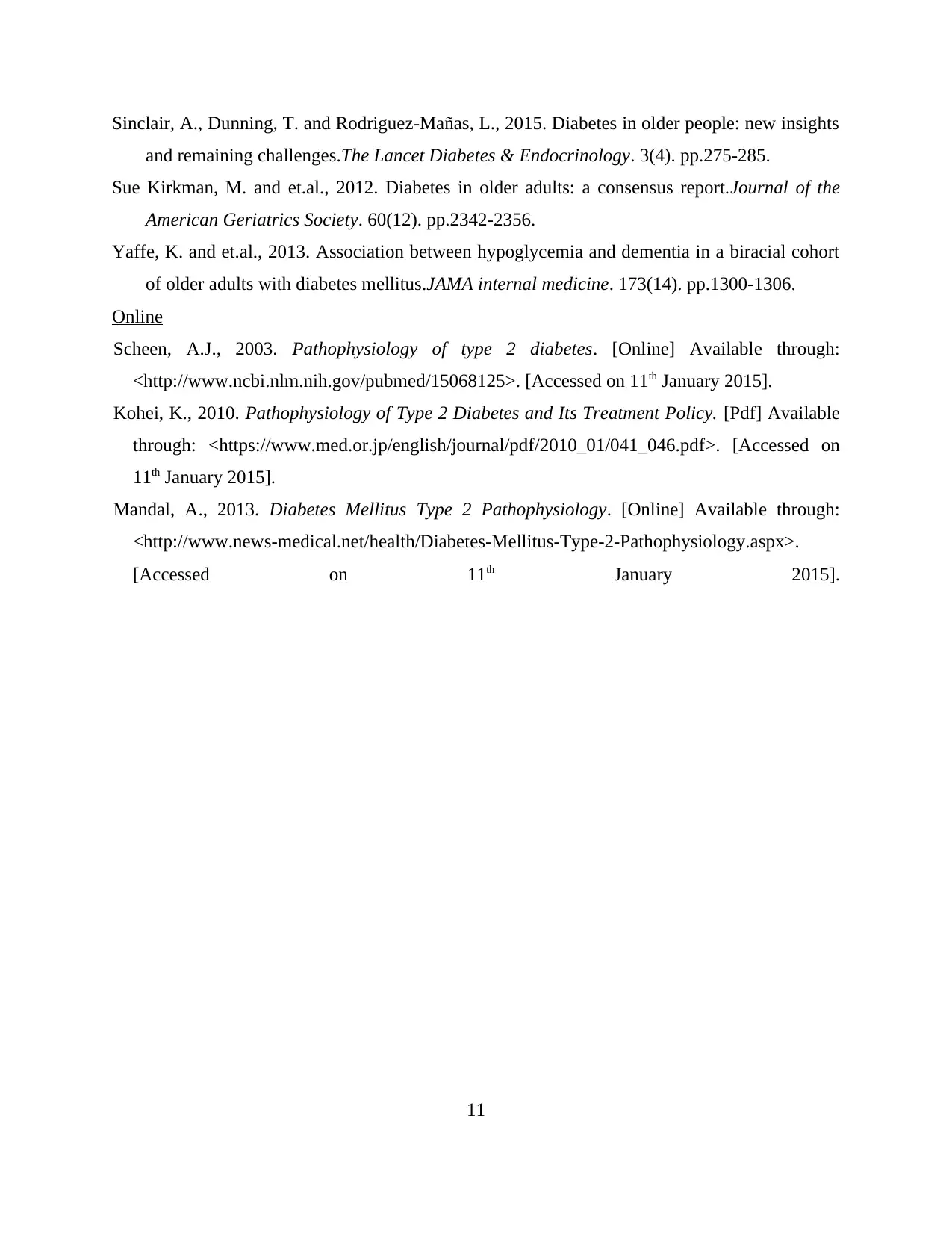
Sinclair, A., Dunning, T. and Rodriguez-Mañas, L., 2015. Diabetes in older people: new insights
and remaining challenges.The Lancet Diabetes & Endocrinology. 3(4). pp.275-285.
Sue Kirkman, M. and et.al., 2012. Diabetes in older adults: a consensus report.Journal of the
American Geriatrics Society. 60(12). pp.2342-2356.
Yaffe, K. and et.al., 2013. Association between hypoglycemia and dementia in a biracial cohort
of older adults with diabetes mellitus.JAMA internal medicine. 173(14). pp.1300-1306.
Online
Scheen, A.J., 2003. Pathophysiology of type 2 diabetes. [Online] Available through:
<http://www.ncbi.nlm.nih.gov/pubmed/15068125>. [Accessed on 11th January 2015].
Kohei, K., 2010. Pathophysiology of Type 2 Diabetes and Its Treatment Policy. [Pdf] Available
through: <https://www.med.or.jp/english/journal/pdf/2010_01/041_046.pdf>. [Accessed on
11th January 2015].
Mandal, A., 2013. Diabetes Mellitus Type 2 Pathophysiology. [Online] Available through:
<http://www.news-medical.net/health/Diabetes-Mellitus-Type-2-Pathophysiology.aspx>.
[Accessed on 11th January 2015].
11
and remaining challenges.The Lancet Diabetes & Endocrinology. 3(4). pp.275-285.
Sue Kirkman, M. and et.al., 2012. Diabetes in older adults: a consensus report.Journal of the
American Geriatrics Society. 60(12). pp.2342-2356.
Yaffe, K. and et.al., 2013. Association between hypoglycemia and dementia in a biracial cohort
of older adults with diabetes mellitus.JAMA internal medicine. 173(14). pp.1300-1306.
Online
Scheen, A.J., 2003. Pathophysiology of type 2 diabetes. [Online] Available through:
<http://www.ncbi.nlm.nih.gov/pubmed/15068125>. [Accessed on 11th January 2015].
Kohei, K., 2010. Pathophysiology of Type 2 Diabetes and Its Treatment Policy. [Pdf] Available
through: <https://www.med.or.jp/english/journal/pdf/2010_01/041_046.pdf>. [Accessed on
11th January 2015].
Mandal, A., 2013. Diabetes Mellitus Type 2 Pathophysiology. [Online] Available through:
<http://www.news-medical.net/health/Diabetes-Mellitus-Type-2-Pathophysiology.aspx>.
[Accessed on 11th January 2015].
11
1 out of 11
Related Documents
Your All-in-One AI-Powered Toolkit for Academic Success.
+13062052269
info@desklib.com
Available 24*7 on WhatsApp / Email
![[object Object]](/_next/static/media/star-bottom.7253800d.svg)
Unlock your academic potential
© 2024 | Zucol Services PVT LTD | All rights reserved.





